Autumn Color in California

We can't claim to rival New England or the Rockies for autumn color, but we have our moments. Of course, color is best in USDA Zones 8 and lower -- especially in years when we have an early cold spell. Be sure to select these deciduous trees while the leaves are showing autumn color, which varies with individual trees.

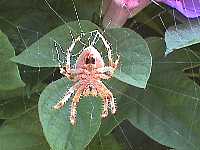 Big garden spiders are found everywhere in the autumn. Be careful when
you're walking through shrub beds. If you're looking down and raking
the ground, you just might find one of these and the web in your face.
Big garden spiders are found everywhere in the autumn. Be careful when
you're walking through shrub beds. If you're looking down and raking
the ground, you just might find one of these and the web in your face.
 Chinese Pistache is becoming more and more popular in our landscapes.
It has a moderate rate of growth and is not particular as to water. It
is drought tolerant but grows well in lawns too. It turns red and
orange and even yellow in the fall.
Chinese Pistache is becoming more and more popular in our landscapes.
It has a moderate rate of growth and is not particular as to water. It
is drought tolerant but grows well in lawns too. It turns red and
orange and even yellow in the fall.
 California Sycamore turns yellow (and brown) in the fall. But interest
is not only in the foliage. The seed clusters last through the winter.
It's a native that grows along streams all over California.
California Sycamore turns yellow (and brown) in the fall. But interest
is not only in the foliage. The seed clusters last through the winter.
It's a native that grows along streams all over California.
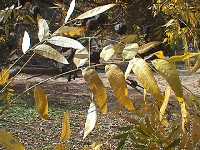 Black Walnut is another California native. Juglands hindsii
is a 30 to 60 foot tree and is native to Northern California.
Juglands californica is more shrub-line, growing 15 to 30 feet,
and is native to Southern California. These trees turn an intense
yellow in the fall.
Black Walnut is another California native. Juglands hindsii
is a 30 to 60 foot tree and is native to Northern California.
Juglands californica is more shrub-line, growing 15 to 30 feet,
and is native to Southern California. These trees turn an intense
yellow in the fall.
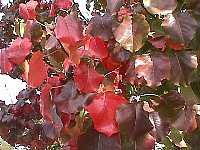 Pyrus calleryana is a deciduous tree that comes in many
varieties, Bradford Pear being the most planted. The varieties have
different shapes and fall color, which varies from yellow to orange to
red. As with all trees desired for fall color, buy the plant in the
fall.
Pyrus calleryana is a deciduous tree that comes in many
varieties, Bradford Pear being the most planted. The varieties have
different shapes and fall color, which varies from yellow to orange to
red. As with all trees desired for fall color, buy the plant in the
fall.
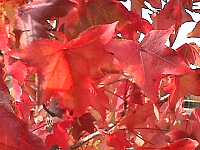 Liquidambar styraciflua (Sweet Gum) is our most popular tree
for fall color. Select from many varieties with red, orange and/or
yellow autumn leaves. It has an upright form and is often used as a
street tree.
Liquidambar styraciflua (Sweet Gum) is our most popular tree
for fall color. Select from many varieties with red, orange and/or
yellow autumn leaves. It has an upright form and is often used as a
street tree.
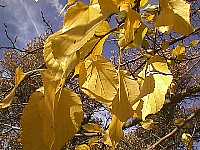 Morus alba (Fruitless Mulberry) is a large, fast growing tree
that is best suited to large properties. Many people cut back the
branches every year, a technique caled pollarding. The leaves are
bright yellow in autumn.
Morus alba (Fruitless Mulberry) is a large, fast growing tree
that is best suited to large properties. Many people cut back the
branches every year, a technique caled pollarding. The leaves are
bright yellow in autumn.
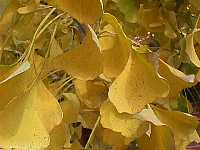 Ginko biloba (Maidenhair Tree) is an ancient tree related to
the conifers, but it has a broad, fan-shaped leaf. It's a slow
growing tree that usually tops out at 35 to 50 feet. Only male trees
are planted because the fruit is abundant and smelly. Autumn color is
a golden yellow.
Ginko biloba (Maidenhair Tree) is an ancient tree related to
the conifers, but it has a broad, fan-shaped leaf. It's a slow
growing tree that usually tops out at 35 to 50 feet. Only male trees
are planted because the fruit is abundant and smelly. Autumn color is
a golden yellow.
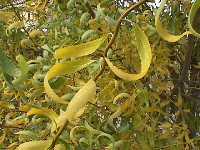 Salix babylonica is the Corkscrew Willow. The stems are
twisted, and so are the leaves, which turn bright yellow in the fall.
The stems are interesting even without leaves -- in the winter.
Salix babylonica is the Corkscrew Willow. The stems are
twisted, and so are the leaves, which turn bright yellow in the fall.
The stems are interesting even without leaves -- in the winter.
 Wisteria is a woody vine that is planted for its pendulous, violet
flower clusters that bloom in the spring. The leaves turn a golden
yellow in the fall.
Wisteria is a woody vine that is planted for its pendulous, violet
flower clusters that bloom in the spring. The leaves turn a golden
yellow in the fall.
 Parthenocissus...
Boston Ivy and Virginia Creeper are clinging vines that turn an
intense red in autumn. They make a very nice cover for a block wall.
Parthenocissus...
Boston Ivy and Virginia Creeper are clinging vines that turn an
intense red in autumn. They make a very nice cover for a block wall.

© 1997 by Jim Clatfelter.
 Go to
Garden California Home Page
Go to
Garden California Home Page
This page hosted by
![]() Get your own Free Home Page
Get your own Free Home Page
